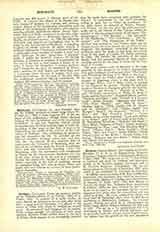

Bordone, CAVALIERE PARIS, an eminent painter of the Venetian school, b. at Treviso, 1500; d. at Venice, 1570. A member of a noble family, he early showed an inclination for art and, after being given a good general education, was placed in the school of Titian with whom he studied for several years. He afterwards had Giorgione for his master. While feeling strongly the influence of both great painters, Bordone finally settled down to the style of Titian, whose manner he so successfully imitated that his works have sometimes been mistaken for Titian‘s. In portraiture he was most successful, ceding to none but to Titian in excellence. In his early career he painted at Venice, Vicenza, and Treviso. At the last place his most important work was in the church of San Vicenzo, where he painted in the six compartments of the dome “The Annunciation”, “The Nativity”, “The Adoration of the Shepherds”, “The Crucifixion”, “The Ascension“, and “The Assumption of the Virgin”. Bordone was invited to visit France, some say by Francis I, and others by Francis II, by whom he was knighted. He remained, according to the latter authority, after the death of that king, for several years at the court of Charles IX, before returning to Italy. He painted the portraits of the royal family and the principal figures of their courts, working notably for the Duke of Guise and the Cardinal de Lorraine.
The most famous work of Bordone is the large painting in the Academy at Venice, representing with great brilliancy of color and effect “The Fisherman Presenting the Ring of St. Mark to the Doge”. On his return to Venice from France, Bordone stopped at Augsburg, where he did some work in the Fugger Palace, and at Milan, where he painted in the chapel of St. Jerome. Among the principal works of Bordone in European galleries are: Louvre, “Vertumna and Pomona”, “Portrait of a Man“, and “Portraits (presumed) of Philip II, King of Spain, and his Preceptor”; National Gallery, London, “Daphnis and Chloe”, and “Portrait of a Genoese Lady”; Berlin Museum, “Madonna and Saints”, “The Chess Players”, and “Man in Black”; Dresden Gallery, “Holy Family with St. Jerome and St. Elizabeth“, and “Diana, Apollo and Marsyas”; Munich, Old Pinakotek, “Portrait of a Man“, and “Man Counting Jewels”; Vienna Gallery, seven works including “Venus and Adonis in an Arbor”, and “A Young Lady at her Toilet”; St. Petersburg Hermitage, “Madonna and Saints”; Brera, Milan, “Baptism of Christ”; Venice, Academy, “Presenting the Ring”, and “The Tiburtine Sibyl”; Rome, Colonna Palace, “Holy Family“; Doria Palace, “Mars and Venus”; Padua Gallery, “Christ Taking Leave of His Mother”; Lovere, Tadini Collection, “Madonna and Two Saints”; Genoa, Brignole Palace, two portraits.
AUGUSTUS VAN CLEEF

